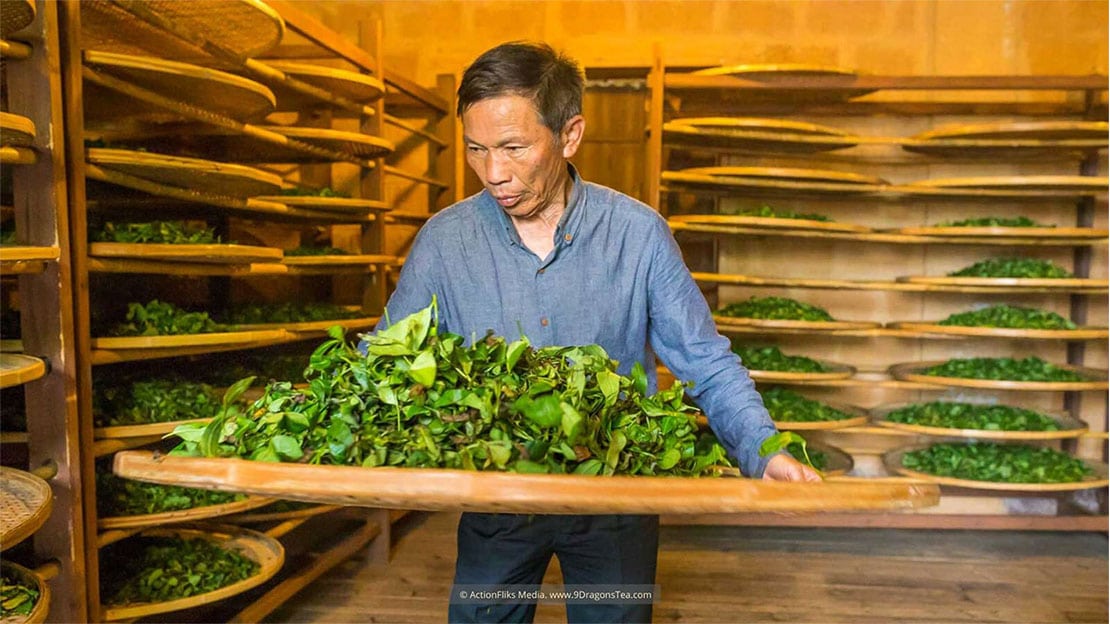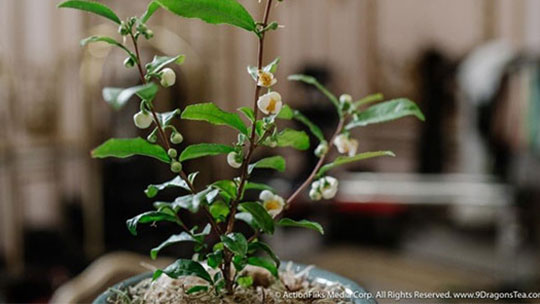
Origin Of Black Tea
Lapsang Souchong Influenced The World
A sip of culture for your thoughts


Today, tea is the most popular beverage around the world, second only to water. Have you ever wonder about tea’s origin and how loose leaf tea is processed? The traditional tea-making technique was steeped in mystery ever since Europeans started drinking tea in the 1600s, but the ancient tea-making process remained a well-guarded secret until the mid-1800s.
The question: How did the Chinese tea-making secrets get out made a fascinating chapter in the film 9 DRAGONS TEA. In this article, we’ll discuss how tea began in China and the 15 major steps in traditional Chinese tea-making that fascinated Westerners for more than 300 years.
Tea originated in ancient China. Made from the amazing plant – Camellia Sinensis – tea began as a southerner’s drink. Then this beloved beverage spread to the northern regions of China, where the capital was located.
The art of Chinese tea-making has evolved over thousands of years, passing down from generation to generation.
By the mid-7th century, or Tang dynasty, tea became a national drink in China. A countrywide cottage industry, tea-making was a way of life. Tea was an art form, a currency. Tea was infused into every aspect of Chinese culture.
In the world of tea, there are six tea types: White tea, Yellow tea, Green tea, Oolong tea, Black tea, and Pu-er (or Pu’erh, aka Dark tea or “Hei Cha” in Chinese). All of these teas are made from Camellia sinensis.
So what makes each cup of tea you hold different is how the tea leaves are processed. Amazing, right? Which tea is the most complex to make? Oolong tea.


In Chinese culture, the tea-making process has evolved and refined over thousands of years. Traditionally, Chinese tea-making had always been artisanal and hand-crafted, consisting of 15 essential steps.
It’s worth noting that major tea-producing countries, such as Japan, India, Sri Lanka, and Africa, all adopted the traditional Chinese tea-making techniques. Some of these original methods were further evolved, giving us unique teas that we all love today—the Japanese shaded Green tea is an excellent example.
Note that some of these steps may vary depending on the type of tea being produced. For example, White tea and Green tea are relatively easier to make than, say, Black tea or Oolong tea, and therefore some steps are unnecessary. To give you a full picture of all the significant efforts involved, I’ve included extra steps to make Oolong tea.
Tea farmers must remove the weeds and plow the field to loosen the soil, preparing for the seeds’ good growing conditions. This step ensures their roots can reach deeper for better absorption of moisture and nutrients.
Farmers divide the field into strips of plots separated by furrows. Then they dig small holes, placing three to five seeds into each hole and covering each hole with soil.
Farmers water the field twice daily, in the morning and at night, until the seeds start to root. Afterward, the seedlings are to be watered every couple of days to keep the soil moist.
Tea picking happens during the spring. Plucking is done by pinching the plant between the thumb and the index finger. The higher the grade, the fewer the leaves beneath the bud are plucked. For example, for ultra-fine tea, only the bud is plucked.
The more leaves below the bud, the lower the grade of tea. There are usually up to five leaves.
Depending on the growing districts, there are multiple pickings. For example, first picking or the first flush makes the finest tea as tea pickers pluck only the bud. Then it moves downward in second picking or second flush, etc.
Tea pickers remove all the impurities, such as withered, yellow leaves and stalks, keeping only the tender leaves and buds. Young girls and women traditionally take up this job.
Workers spread out the leaves for natural drying. This step removes moisture while activating the leaves’ enzymes to stimulate the chemical reaction to produce tea juice.
Withering looks from women hurt! That’s not a fun fact! But it’s true. Properly withered tea leaves HEAL. Perhaps you ought to consider offering her a warm cuppa🍵 first instead of asking what is her zodiac sign? 💘
Shake Green is an extra step in Oolong tea-making. The shaking motion bruises the leaves’ edges, triggering fermentation.
Shake Green gives Wuyi Rock tea, or Wuyi Oolong tea, the signature “green leaves, red edges” element.
We captured this critical step on camera for the film 9 DRAGONS TEA. Tea’s sweet scent filled the entire chamber during the Shake Green process. What a delightful moment that was.
Tea master stir-fries the tea leaves in a large wok. This process deactivates the enzymes to cause oxidation, thereby preserving the leaves’ green color. It also brings out tea’s natural aromas.
Also known as Stir-Green, or Kill-Green, this is a defining moment for tea-masters. When to start Stir Green or how long to pan-fry the tea leaves? These are the things that make a “Shifu” or “master” in Chinese.
Rolling the withered tea leaves breaks down the cellular structures within the leaves, causing fermentation. The constant pressing and twisting action gather the tea juice onto the surface of the leaves. When done well, this is what gives the tea its integrity in taste and flavor profile.
This step is crucial in Oolong tea-making. In Wuyi Oolong, this action turns the leaves into thinly twisted form, giving rise to the name “Wu Nong,” meaning “black dragon” in Chinese. No surprises there, as the Chinese are really into dragons.
The tightly twisted tea leaves are placed in bamboo containers sitting atop an oven. The room is temperature-controlled. Tea masters toss the tea leaves inside the bamboo box until they are dried.
Using bamboo sieves, workers sift tea leaves to remove dust and other impurities.
Workers pack the well-prepared tea leaves into bamboo baskets for sellers in town.
Traditionally, tea is transported by river from the growing regions to the sellers in towns or cities. In China’s ancient days, bamboo rafts were the go-to choice for transportation. There, farmers and agents made tea deals to sell the tea.
Tea merchants arrange to transport tea barrels to the warehouse for repackaging and exporting to various European countries.
Workers load the tea chests onto the ships for exporting to European countries.
As you can see, a single cup of tea takes a great deal of work. In the 18th century, tea took about 12 months to arrive from China to London via tea clippers, also known as “East Indiaman” or tea wagons. Tea traveled a very long journey from China to Europe.
“So cherish each cup of tea. Cherish each sip.”

Tea for your thought: If you find anything in this article that’s interesting, please do share. We’d love to hear your thoughts, as this will help guide us in writing future articles.
Be sure to join our mailing list for exclusive tea-tasting and screening events. Cheers!
Brimming with ZEST. Consummate cultivator of ideas from sparks to fruit-bearing adventures. I love pursuing worthy causes elevating the human spirit. Care to join me for tea?

Lapsang Souchong Influenced The World

Discover the zodiac animal within you and fun tea drinks to go along with your winning personality!

Craving Chinese food and fun social gatherings? Explore the Dim Sum tea essentials here.

Southern Spiced Chai Recipe simmers in exotic harmony. ☕️
Join the Tea Party
Get exciting news on the film and
special events poured straight into your inbox.
9 DRAGONS TEA is a registered trademark & © 2020-2024 ActionFliks Media Corp. All Rights Reserved. | Privacy Policy | Terms of Use
9 DRAGONS TEA is a registered trademark & © 2020-2024 ActionFliks Media Corp. All Rights Reserved. | Privacy Policy | Terms of Use